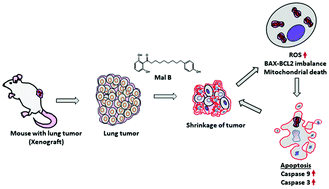当前位置:
X-MOL 学术
›
Food Funct.
›
论文详情
Our official English website, www.x-mol.net, welcomes your feedback! (Note: you will need to create a separate account there.)
Spice-derived phenolic, malabaricone B induces mitochondrial damage in lung cancer cells via a p53-independent pathway†
Food & Function ( IF 6.1 ) Pub Date : 2018-09-18 00:00:00 , DOI: 10.1039/c8fo00624e Mrityunjay Tyagi 1, 2, 3, 4, 5 , Biswanath Maity 1, 2, 3, 4 , Bhaskar Saha 1, 2, 3, 4 , Ajay Kumar Bauri 1, 2, 3, 4 , Mahesh Subramanian 1, 2, 3, 4, 5 , Subrata Chattopadhyay 1, 2, 3, 4, 5 , Birija Sankar Patro 1, 2, 3, 4, 5
Food & Function ( IF 6.1 ) Pub Date : 2018-09-18 00:00:00 , DOI: 10.1039/c8fo00624e Mrityunjay Tyagi 1, 2, 3, 4, 5 , Biswanath Maity 1, 2, 3, 4 , Bhaskar Saha 1, 2, 3, 4 , Ajay Kumar Bauri 1, 2, 3, 4 , Mahesh Subramanian 1, 2, 3, 4, 5 , Subrata Chattopadhyay 1, 2, 3, 4, 5 , Birija Sankar Patro 1, 2, 3, 4, 5
Affiliation

|
The spice-derived phenolic, malabaricone B (mal B) showed selective toxicity to human lung cancer (A549), malignant melanoma (A375) and T cell leukemia (Jurkat) cell lines, without showing toxicity to human normal intestinal (INT407), human kidney (HEK293) and lung fibroblast (WI-38) cells. Among the chosen cancer cell lines, mal B showed maximum cytotoxicity to the A549 cells (IC50 = 8.1 ± 1.0 μM), which was significantly better than that of curcumin (IC50 = 26.7 ± 3.1 μM). Further morphological studies by phase contrast microscopy and a clonogenic assay of the A549 cells revealed that mal B treatment increased the number of shrinking cells and also abolished the clonal proliferation of the cells. Mal B induced apoptotic cell death was confirmed by DNA laddering and quantified by cytoplasmic oligonucleosome formation and annexin V/PI assays. The mal B-induced apoptosis was mediated by an increase in the intracellular reactive oxygen species (ROS), because the cell-permeable antioxidants, N-acetylcysteine (NAC) and PEG-SOD, strongly inhibited its cytotoxicity to the A549 cells. Mal B increased the BAX level while simultaneously decreasing the BCL-2 and BCL-XL levels in the A549 cells, triggering the mitochondrial apoptotic pathway as revealed from the release of cytochrome c, and the activation of caspase-9 and caspase-3. Pre-treatment of cells with caspase-9, caspase-3 and pan-caspase inhibitors made them more resistant to mal B treatment. This effect of mal B was strongly associated with the concomitant decrease in anti-apoptotic (IAP1, IAP2 and survivin), angiogenic (growth factors) and cancer invasiveness (matrix metalloproteinase-9, COX-2) modulating proteins. Mal B induced cytotoxicity was unaffected by the shRNA-mediated depletion of p53 in A549 cells. Most importantly, mal B sensitized a wide range of human carcinoma cells regardless of their p53 status. Finally, mal B (100 mg kg−1) also inhibited lung tumor (xenograft) growth in SCID mice.
中文翻译:

香料衍生的酚类,马拉巴酮B通过非p53途径诱导肺癌细胞的线粒体损伤†
香料衍生的酚类,马拉巴酮B(mal B)对人肺癌(A549),恶性黑色素瘤(A375)和T细胞白血病(Jurkat)细胞系表现出选择性毒性,而对人正常肠道(INT407)无毒性肾(HEK293)和肺成纤维细胞(WI-38)细胞。在所选的癌细胞系中,mal B对A549细胞表现出最大的细胞毒性(IC 50 = 8.1±1.0μM),明显优于姜黄素(IC 50)。= 26.7±3.1μM)。通过相差显微镜和对A549细胞的克隆形成分析的进一步形态学研究显示,mal B处理增加了收缩细胞的数量,也消除了细胞的克隆增殖。DNA梯形证实了Mal B诱导的凋亡细胞死亡,并通过胞质寡核小体形成和膜联蛋白V / PI分析进行了定量。mal B诱导的细胞凋亡是由细胞内活性氧(ROS)的增加介导的,因为细胞可渗透的抗氧化剂N-乙酰半胱氨酸(NAC)和PEG-SOD强烈抑制了其对A549细胞的细胞毒性。Mal B增加了BAX的水平,同时降低了BCL-2和BCL-X L从细胞色素c的释放以及caspase-9和caspase-3的激活所揭示的水平来看,A549细胞中A549的水平升高,触发了线粒体凋亡途径。用caspase-9,caspase-3和pan-caspase抑制剂预处理细胞后,它们对mal B治疗的抵抗力就会增强。mal B的这种作用与抗凋亡(IAP1,IAP2和survivin),血管生成(生长因子)和癌症侵袭性(基质金属蛋白酶9,COX-2)调节蛋白的降低密切相关。Mal B诱导的细胞毒性不受A549细胞中shRNA介导的p53消耗的影响。最重要的是,无论B53处于何种状态,mal B都能使多种人类癌细胞敏感。最后,mal B(100 mg kg -1)也抑制了SCID小鼠的肺肿瘤(异种移植)生长。
更新日期:2018-09-18
中文翻译:

香料衍生的酚类,马拉巴酮B通过非p53途径诱导肺癌细胞的线粒体损伤†
香料衍生的酚类,马拉巴酮B(mal B)对人肺癌(A549),恶性黑色素瘤(A375)和T细胞白血病(Jurkat)细胞系表现出选择性毒性,而对人正常肠道(INT407)无毒性肾(HEK293)和肺成纤维细胞(WI-38)细胞。在所选的癌细胞系中,mal B对A549细胞表现出最大的细胞毒性(IC 50 = 8.1±1.0μM),明显优于姜黄素(IC 50)。= 26.7±3.1μM)。通过相差显微镜和对A549细胞的克隆形成分析的进一步形态学研究显示,mal B处理增加了收缩细胞的数量,也消除了细胞的克隆增殖。DNA梯形证实了Mal B诱导的凋亡细胞死亡,并通过胞质寡核小体形成和膜联蛋白V / PI分析进行了定量。mal B诱导的细胞凋亡是由细胞内活性氧(ROS)的增加介导的,因为细胞可渗透的抗氧化剂N-乙酰半胱氨酸(NAC)和PEG-SOD强烈抑制了其对A549细胞的细胞毒性。Mal B增加了BAX的水平,同时降低了BCL-2和BCL-X L从细胞色素c的释放以及caspase-9和caspase-3的激活所揭示的水平来看,A549细胞中A549的水平升高,触发了线粒体凋亡途径。用caspase-9,caspase-3和pan-caspase抑制剂预处理细胞后,它们对mal B治疗的抵抗力就会增强。mal B的这种作用与抗凋亡(IAP1,IAP2和survivin),血管生成(生长因子)和癌症侵袭性(基质金属蛋白酶9,COX-2)调节蛋白的降低密切相关。Mal B诱导的细胞毒性不受A549细胞中shRNA介导的p53消耗的影响。最重要的是,无论B53处于何种状态,mal B都能使多种人类癌细胞敏感。最后,mal B(100 mg kg -1)也抑制了SCID小鼠的肺肿瘤(异种移植)生长。


























 京公网安备 11010802027423号
京公网安备 11010802027423号